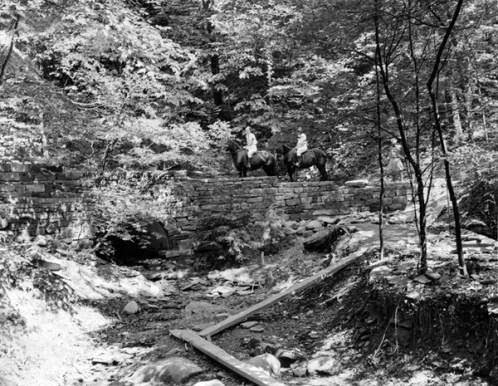 Newspapers are among some of my favorite resources to use for family history research. They can
Newspapers are among some of my favorite resources to use for family history research. They canilluminate our ancestor's lives in very personal ways. Learn how to use newspapers in research HERE.
But newspapers can also give you insight into the community and the times that your ancestors lived in.
And they can be entertaining.
For years, the Medina County District Library has maintained an online obituary index to death notices that have occurred in the Medina Gazette and the Medina Sentinel. The index was started in 1982 and was first entered onto 3" X 5" index cards.
 |
| Index card from the original obituary index. The red line across the top indicated that the listing had been added to the online database. |
Over the years it has expanded and migrated and now lives on the Library's web site HERE.
The listings have been collected and entered by Library staff and volunteers. The work consists of reading through the newspaper microfilm, filling out the form with all the information and then entering the data into a computer. The work can be very monotonous. Boring.
And the articles can be depressing.
 |
| The awful tragedy appeared in the September 5, 1933 Medina Gazette |
 |
| This obituary for Lydie Welday in the November 13, 1908 Medina Gazette displays the embellished language that was more normal in the past. |
But, occasionally, the volunteers came across a particularly interesting article...
Luckily, they have shared many of these with me.
And now, I will share them with you!
ANIMALS
As you would expect from a rural county, many of the newspaper articles covered animals. But these are not the prize-winning-sow-at-the-county-fair kind of articles.
What I find particularly fascinating is that during these same time periods, a person's death might not get any mention, or a very brief line. But animals??
Lets start with CHICKENS!
 |
| Who would have thought that the death of three chickens was newsworthy? Slow news day? Medina Gazette 4 Sep. 1902, page 6. |
 |
| This incident is a little bizarre, so somewhat newsworthy. Medina Gazette 20 Nov. 1908, page 5 |
 |
| Along the same lines as the chicken story above. Medina Gazette 24 Mar. 1881, page 1. |
 |
| Is there some significance to the ear of corn in her mouth? Did she overeat, or choke to death? What happened? Medina Gazette 2 Aug. 1907, page 6. |
Horse stories abound. And apparently people were fond of their neighbor's horses...
 |
| Seems like everyone knew "Old Jim" Medina Gazette 2 Aug. 1907, page 2. |
 |
| "Old Ned" delivered the mail on a Rural Free Delivery Route. Medina Gazette 14 Feb. 1908, page 6. |
 |
| "Old Tobey" must have been VERY popular. I have seen shorter death notices for women! Medina Gazette 5 March, 1909, page 5. |
Many women of the time did not get as much coverage at their death as Old Tobey did!
Now for a few words for our favorite animals - family pets!
 |
| Strangely, only one article in my files deals with a cat. Medina Gazette 31 July 1942, page 12. |
 |
| Seems the writer of this article was as attached to "Scott" as his owner was! Medina Gazette 10 Dec 1909, page 7 |
 |
| WOW! We learn how long the dog had been ill and that he had been in the care of the vet for months! Medina Gazette 7 June 1935, page 1. |
And the final article on animals defies labeling...
 |
| Some friend, eh? Medina Gazette 25 March, 1910, page 5. |
And next we will take a look at some notices of the not quite dead... But not ZOMBIES!
NOT A ZOMBIE!
Just more lessons on not believing everything you read.
NOT A ZOMBIE!
Just more lessons on not believing everything you read.
The movie Somersby had nothing on this story...
 |
| This soldier took Southern hospitality too seriously, abandoning his wife, and committing bigamy with the farmer's daughter! Medina Sentinel 4 Dec 1903, page 1. |
Apparently, during World War I, the United States was not really good at keeping track of their soldiers...
 |
| He's alive and he's a new Dad! Medina Gazette 8 Nov. 1918, page 11. |
You would think the hospital could keep track of their patients.
 |
| Imagine the celebration his family had! Medina Gazette 22 Nov 1918, page 2. |
 |
| Howard lived to see the U.S. return to fight Germany again. He died in April 1942 Medina Gazette, 27 Dec 1918 p. 6 |
 |
Really? No resting after a heart attack?
Medina Gazette 2 July 1935, page 1.
|
Undoubtedly, Anna has since passed away. But repeated searching failed to turn up a death record or tombstone listing.
BIZARRE HAPPENING
This event was probably terrifying for the victims. But I can't help but wonder if they all thought they were being collected by the devil en masse...
 |
| Medina Sentinel 29 April 1904 p. 1 |
MISSING!
All sorts of things go missing...
 |
| Medina Gazette 14 Aug 1908 p. 5 |
How embarrassing! I am guessing that person didn't smile after that!
And from the article below, it seems the "chompers" had been missing for quite a while!
 |
| Medina Gazette 9 Oct 1908 p. 5 |
And of course, money frequently goes missing as this following article details:
 |
| Missing Money - Gazette 4 Sep 1902 p. 6 |
 |
| Medina Gazette 11 Sep 1902 p. 7 |
But what is lost, can be "found" again...
But then again, now all of Medina County knows where he keeps his money!
And of course, people go missing for all sorts of reasons.
 |
| Medina Gazette 15 Feb 1965 p. 12 |
But why would she want to visit him?
And back in the days before "political correctness" became a buzz phrase, the newspapers told it like it was...
 |
| Medina Gazette 3 Aug 1906 p. 6 |
 |
| Medina Gazette 12 April 1907 |
The fellow in the article seems like such a sentimental guy - NOT!
The following two articles are even more chauvinistic!
 |
| Medina Sentinel 4 Jan 1900 |
 |
| Medina Sentinel 11 Dec 1902 |
Apparently, the Doctor thought he was above chopping his own wood...
 |
| Medina Gazette 23 Dec 1910 p. 5 |
This next article is just bizarre!
 |
| Medina Gazette 26 Aug 1897 p. 6 |
The next two articles were funny, because the volunteer working on gathering data wanted to know if she should include them in the obituary index...
 |
| Medina Sentinel 15 Nov 1918 p. 1 P.S. This was the editor's cute way of announcing the passage of the Prohibition Act. |
 |
| Medina Sentinel 15 Nov 1918 "Kaiser Bill" was Kaiser Wilhelm - the leader of Germany during World War I. |
And this one struck me funny because of the name...
 |
| Medina Gazette 4 Dec 1934 p. 3 |
In all fairness to Donald's parents, Disney's cartoon character was created the very year this article appeared...
But I wonder if it contributed to what followed....
 |
| Medina Gazette 14 April 1941 |
And this is what click bait looked like before the Internet and Facebook...
And if you have reached all the way to the end, let me know and I will give you a Hershey's Kiss!






